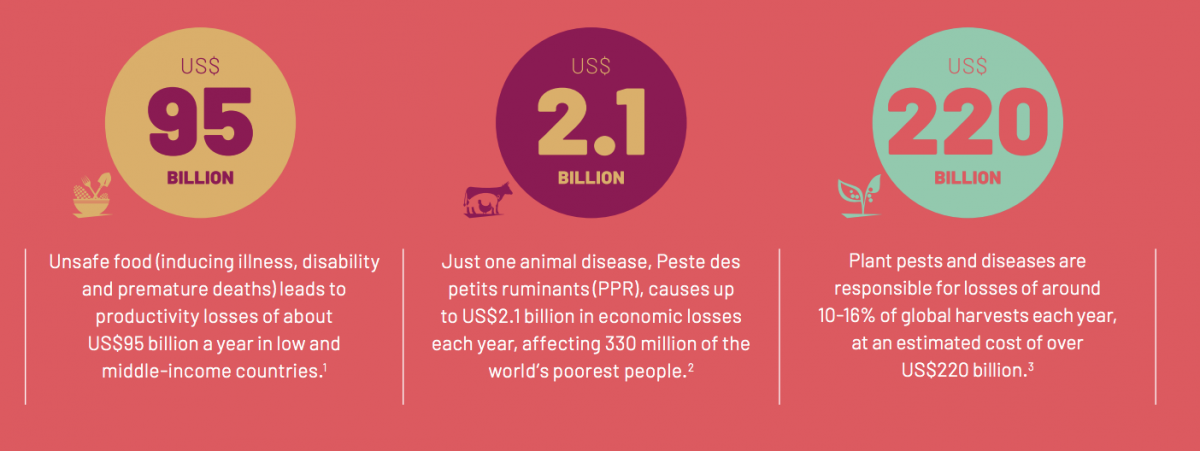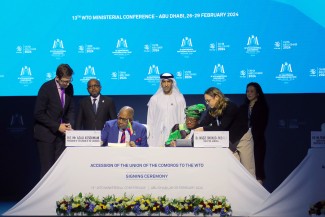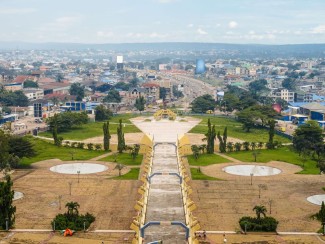COVID-19 is highlighting the interconnectedness of agri-food trade; and work needs to be done to mobilise action to build safe food systems
The COVID-19 pandemic is wreaking havoc with people’s lives and livelihoods, and the effects are being felt most keenly by the most vulnerable. Estimates from the World Bank point to the fact that 100 million people could now be pushed into extreme poverty, while UNCTAD reports that world trade could drop by around 20% in 2020. In developing countries, many of the sectors that had generated jobs and economic growth over the last decade have been most affected, from fruit and vegetables to cut flowers and tourism.
[related-article]
At the same time, the pandemic highlights the interconnectedness of global supply chains, including agri-food trade. And it shows the ease with which plant pests and animal diseases can cross borders and how zoonoses – diseases transmissible from animals to humans – can spread, exposing the need for a coordinated effort to manage their impact. Yet in developing and least developed countries (LDCs), where health systems, infrastructure and resources face existing gaps, regulators and the private sector – especially small businesses – confront huge challenges to respond.
Building resilience: A focus on food safety, animal and plant health
The devastating nature of the pandemic underscores the urgent need to mobilise action and investment to improve food safety and animal and plant health systems that facilitate safe trade. It also shows the need to build the resilience of public and private sector actors in to respond to recognised threats, including the climate crisis.
Building food safety and plant and animal health is a global public good. Many governments and businesses recognise the need to improve their systems and capacity to protect the health of their populations, animals and plants. They also see the value of doing so to promote access for agri-food products to regional and international markets.
But realising improvements requires more financial resources, infrastructure and technical skills, as well as new and innovative approaches that connect the public and private sectors.
The opportunities: Scaling and speeding up solutions on safe trade
When it comes to facilitating safe trade in developing countries and LDCs, the price of inaction is far greater than the investments needed. And the costs have added up.

Findings from the World Bank show that unsafe food leads to productivity losses of US$95 billion a year in low and middle-income countries. In turn, the International Plant Protection Convention (IPPC) reports that plant pests and diseases lead to 10-16% of global harvests lost each year at an estimated cost of over US$220 billion. Further, according to the World Organisation for Animal Health (OIE), just one animal disease, PPR or “goat plague”, causes up to US$2.1 billion in economic losses a year, affecting 330 million of the world’s poorest people.
A digital transformation
More can be done to adopt new tools and technologies for low-income countries to meet international standards, boost transparency, and reduce costs and speed up trade flows.
Promising examples to go digital in developing countries include use of remote food safety inspection, and IT tools and data to help predict outbreaks before they occur, like the Standards and Trade Development Facility (STDF) project using mobile devices and a smartphone app for pest surveillance in Asia.
Electronic certification is also playing a key role in facilitating business at borders with paperless trade, including the ePhyto Solution for safe trade in plants and plant products. Through an STDF-backed project, 88 countries – including 51 developing countries and LDCs – are connecting to the ePhyto Hub. National plant protection organisations are already exchanging 11,000 ePhyto certificates each month, with the system able to handle up to 100,000 certificates per day. Going digital is cutting the time and cost of processing paper documents, improving transparency and reducing potential for fraud. This supports safe trade, in turn leading to sustainable economic growth, poverty reduction and food security.
Better use of evidence
Hard choices need to be made to prioritise the most critical investments to boost exports, as countries face many competing demands to improve their capacity with limited resources.
The pandemic highlights the interconnectedness of global supply chains, including agri-food trade. And it shows the ease with which plant pests and animal diseases can cross borders and how zoonoses – diseases transmissible from animals to humans – can spread, exposing the need for a coordinated effort to manage their impact.
To plug the capacity gap, developing countries can use OIE, IPPC and FAO/WHO tools to evaluate the areas most in need, at the same time as the STDF tool to prioritise investments (P-IMA).
In Madagascar, public and private stakeholders used P-IMA to prioritise 16 SPS investment options, linked to policy goals from export growth to agricultural productivity and employment, including for MSMEs, women and youth. Based on the evidence, resources were secured to tackle False Codling Moth, a huge problem for horticulture exports. And the Enhanced Integrated Framework is working with authorities to address other highly ranked investments, such as pesticide residue limits in fruit, vegetables and grain exports.
In an ongoing STDF project, Kenya, Ethiopia, Rwanda, Uganda and Zambia are using P-IMA, in partnership with the Common Market for Eastern and Southern Africa (COMESA) and EIF to select investments that are likely to deliver the greatest impacts linked to policy goals.
Dynamic partnerships
In many countries, public and private sector actors are taking steps to work together more closely to support shared safe trade objectives, including pooling the latest skills, expertise and resources.
In West Africa and Central America, projects supported by STDF are strengthening public-private dialogue on the use of reliable food safety data from food business operators (FBOs), including SMEs, linked to Codex principles and guidelines on voluntary third-party assurance programmes. This is part of a broader move by governments to support a more agile and targeted risk-based regulatory approach. It is also expected to help SMEs, which account for the major share of FBOs in developing countries, to improve their food safety outcomes.
Forging a new global landscape: The pathway to safe, inclusive trade
Even before the pandemic struck, the global trade landscape was changing; regional and South-South trade was expanding dramatically alongside the emergence of global agri-food value chains. Interest worldwide has been growing in the use of new technologies, including blockchain, to transform agriculture trade. And the bar has continued to rise on safety for food and agricultural imports linked to food safety concerns and food fraud.
Recognising these trends and how to capitalise on them, STDF’s Strategy for 2020-2024 sets out a pathway to catalyse safe, inclusive trade outcomes in support of the UN 2030 agenda.
-----------------
Find out how STDF’s global partnership is responding to COVID-19: https://standardsfacility.org/stdf-partnership-updates-covid-19
Download STDF’s 2020-2024 Strategy ‘Safe and inclusive trade horizons for developing countries’: https://standardsfacility.org/new-stdf-strategy
Header image - ©Violeta Gonzalez/EIF
If you would like to reuse any material published here, please let us know by sending an email to EIF Communications: eifcommunications@wto.org.



